ESD Sensitivity Testing of Mini-Circuits ERA-5XSM
1.0 Purpose:
To determine the Electrostatic Discharge Sensitivity of Mini-Circuits Amplifier ERA-5XSM in accordance with Human Body Model (HBM) and Machine Model (MM) ESD sensitivity standards. The failure criterion is: 1dB change in gain and/or 10% change in device voltage.
2.0 Ref.:
ESD STM5.1-1993 (for HBM) and ESD STM5.2-1999 (for MM).
3.0 Human Body Model
Three (3) separate samples were used for each of the different values of ESD voltage: 150V, 200V, 240V, 499V, and 999V. Each sample was subjected to 3 ESD pulses of each polarity at each of 3 pairs of pins: input – output, input – ground, and output – ground, a total of 18 pulses.
Electrical performance testing was done for gain and DC device voltage at 65mA bias current, before and after the ESD pulses. Using the failure criteria of 1dB change in gain or 10% change in device voltage, all devices passed at 499V; at 999V, all 3 failed.
4.0 Machine Model
4.1 Testing per ESD STM5.2-1999
Three (3) separate samples were used for each of the different values of ESD voltage: 50V, 70V, 100V, and 150V. Each sample was subjected to 3 ESD pulses of each polarity at each of 3 pairs of pins: input – output, input – ground, and output – ground, a total of 18 pulses.
Electrical performance testing was done for gain and DC device voltage at 65mA bias current, before and after the ESD pulses. Data are presented in Table 2. Using the failure criteria stated in 1.0, the devices passed at 50V; 2 of the 3 failed at 70V.
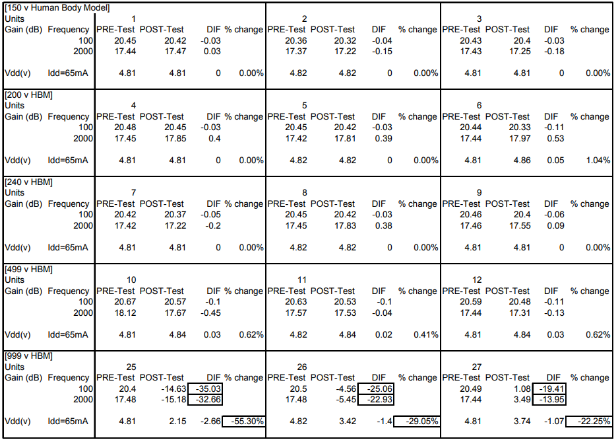
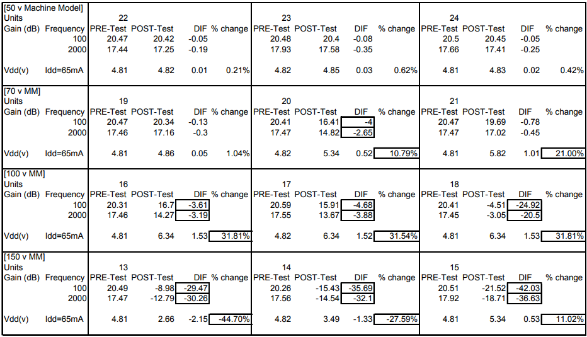
4.2 Additional Machine Model Testing
Additional machine model testing was done in two steps, to evaluate how much performance degradation occurs when progressively increasing ESD voltage is applied to a given device, and when a given ESD voltage is applied repeatedly with performance monitored after each pulse. Separate device samples were used for each of the steps.
The most sensitive pin combination and polarity was determined for ERA-4XSM and reported in AN-60-028: “-” to the input, “+” to the ground. Because the die topology of ERA-5XSM is similar, the most sensitive case should be the same and the following tests were therefore done only for that case.
1. A sequence of ESD pulses with fixed amplitude of 70V was applied to each of 5 units in order to determine cumulative effect of ESD stress.
2. A sequence of ESD pulses with fixed amplitude of 100V was applied to 5 other units in order to determine cumulative effect of ESD stress at that voltage.
Step 1 Test.
Five units were stressed repeatedly with 70V ESD pulses. Electrical tests for gain and device voltage were done after each ESD pulse. The results are shown in Figures 1, 2, and 3. After 5 pulses all 5 units passed the criteria of less than 1dB gain change, but failures occurred against the criterion of 10% device voltage change at the 2nd pulse.
Step 2 Test.
Five units were stressed repeatedly with 100V ESD pulses. Electrical tests for gain and device voltage were done after each ESD pulse. After the first pulse gain dropped by 0.44dB and device voltage increased by 0.83V (that is more than 10%, which would be 0.5V). More 100V ESD pulses caused more degradation in gain and device voltage. After the third pulse at 100V gain is less by 1.27dB, and device voltage is higher by 1.9V.
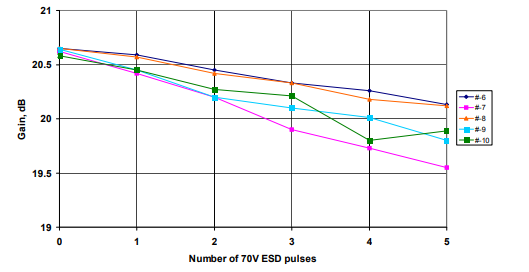
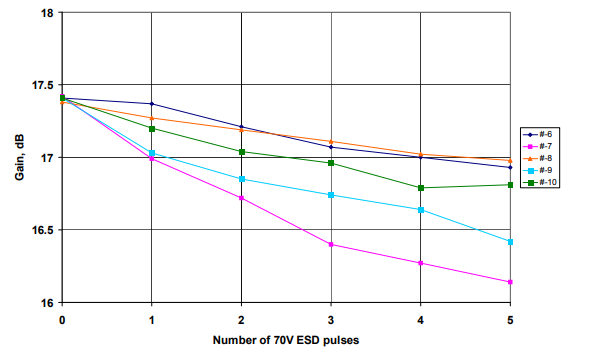
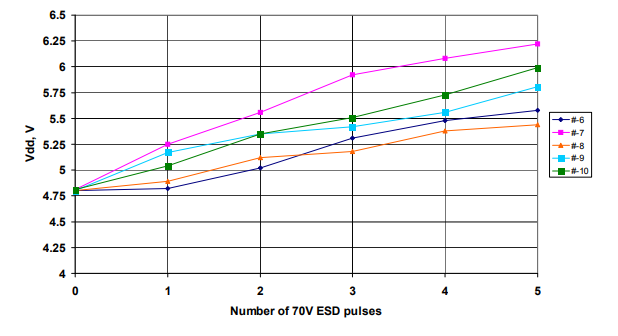
5.0 Conclusions
5.1 Human Body Model:
The new amplifier ERA-5XSM can withstand ESD up to 499V (Class 1A).
5.2 Machine Model:
The new amplifier ERA-5XSM shows gradual degradation in the gain and the device voltage. That fact is not so bad. Even with the multiple stress a customer would rather have gradual changes then catastrophic failure. The amplifier withstands a single 70V ESD pulse, or 3 pulses at 50V.


